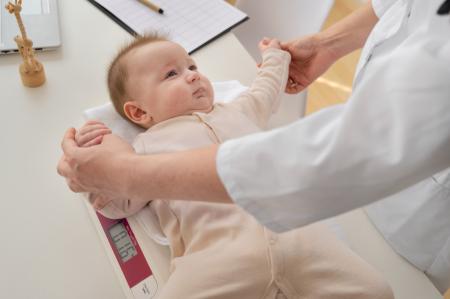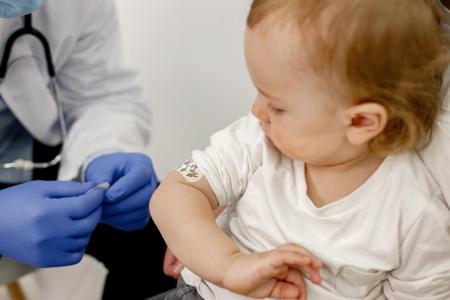The pandemic disrupted child immunization campaigns around the world, and despite the fact that vaccination rates increased in some countries in 2022, progress stagnated in 2023.
Low-income and conflict-affected countries in particular are being left behind, according to new data released by the WHO and UNICEF, which covers immunization statistics in 195 countries.
The Latest Estimates of National Immunization Coverage (WUENIC) report provides the world’s largest and most comprehensive dataset on immunization trends for vaccinations against 14 diseases, WHO reports, underscoring the need for continued efforts to recover and strengthen vaccination system.
“The latest trends show that many countries continue to neglect too many children,” said Catherine Russell, UNICEF’s executive director, in a joint statement, adding that governments and local leaders must invest in primary health care and community workers “to to ensure that every child is vaccinated and that general health care is strengthened”.

More than 50% of unvaccinated children live in conflict-affected countries
Specifically, the report by the two UN agencies shows that the number of children who received three doses of the diphtheria, tetanus and pertussis (DTP) vaccine in 2023 – which is a key indicator of global vaccine coverage, according to the WHO – was 84% (108 million children). This percentage has not changed since 2022, which means that the modest progress observed in that year, after the sudden drop due to the COVID-19 crisis, “has stagnated”, underlines the UN agencies. Before the pandemic, this rate was 86% (2019).
“Global vaccine coverage has not yet fully recovered from the historic decline seen during the pandemic,” emphasizes Dr. Katherine O’Brien, Director of WHO’s Department of Immunization and Vaccines
On the other hand, however, the number of children who did not receive even a single dose of DTP vaccine increased from 13.9 million in 2022 to 14.5 million in 2023.
In addition to the more than 14 million children with “zero doses”, another 6.5 million children were “under-vaccinated”, meaning they did not receive all the recommended doses.
“More than half of unvaccinated children live in the 31 countries with fragile, conflict-affected and vulnerable contexts, where children are particularly exposed to preventable diseases due to disruption and lack of access to safe and health and nutrition services”, states the joint statement of WHO and UNICEF.
“This puts the lives of the most vulnerable children at risk,” said Dr Katherine O’Brien, director of WHO’s Department of Immunization and Vaccines. According to her, children in these countries, in addition to lack of immunization, “also lack security, lack nutrition, lack medical care and, as a result, are most likely to die from a preventable disease vaccine, if they get sick”.
6.5 million children did not receive the third dose of diphtheria, tetanus and pertussis vaccine, which is required to provide protection against these diseases during infancy and early childhood.

Low vaccination is already causing measles epidemics
WHO and UNICEF have expressed concern about the delay in vaccination against measles, a deadly and highly infectious disease, amid an outbreak of epidemics around the world.
Data released by the two agencies shows that measles vaccination rates have also stagnated, with about 35 million children remaining unprotected or only partially protected.
In fact, last year only 83% of children worldwide received the first dose of measles vaccine, while the number of children who received the second dose increased very little from the previous year, reaching 74% of children.
These figures fall far short of the 95% vaccination coverage required to prevent outbreaks, prevent preventable illness and death, and achieve measles elimination goals. Low vaccination coverage has been a major factor in measles outbreaks in recent years.
“Measles outbreaks are the wake-up call, exposing and exploiting gaps in immunization and hitting the most vulnerable first,” says Dr. Tedros Adhanom Ghebreyesus, WHO Director-General, who believes the problem is solvable.
“Measles vaccine is cheap and can be delivered even to the most difficult places. WHO is committed to working with all our partners to support countries to close these gaps and protect the most at-risk children as quickly as possible.”
Dr. Tedros Adhanom Ghebreyesus, Director General of OMS
103 countries – where about three quarters of the world’s children live – have been affected by measles epidemics in the last 5 years. In contrast, 91 countries with robust measles vaccine coverage did not experience epidemics.
Increases immunity against HPV
The UN report also highlights that the steady introduction of new and less-used vaccines, including for human papillomavirus (HPV), meningitis, pneumococcal, poliomyelitis and rotavirus, continues to widen the protective umbrella, particularly in the 57 countries supported by Gavi, Vaccine Alliance. For example, the share of teenage girls worldwide who received at least one dose of the HPV vaccine, which provides protection against cervical cancer, increased from 20% (2022) to 27% (in 2023). This is due in part to the switch from a two-dose to a single-dose vaccination schedule.
Despite the significantly higher percentage compared to 2022, HPV vaccine coverage is well below the 90% goal needed to eliminate cervical cancer as a public health problem. In fact, the HPV vaccination rate reaches only 56% of adolescent girls in high-income countries and 23% in low- and middle-income countries.
Although the HPV vaccine has been shown in practice, not just in studies, to significantly reduce the risk of cervical cancer, it is still not widely available in large countries such as China and India, which have a high burden of the disease, according to the report . Health officials are now trying to address misinformation, which has increased during the pandemic.
In Romania, worse than in war zones
The data regarding our country show that, instead of increasing or at least stagnating, the vaccination rate of children in Romania was decreasing
Thus, the estimates for Romania regarding coverage with the first dose of the DTP vaccine (against diphtheria, tetanus and pertussis) decreased by seven percent in a single year: from 89% in 2022 to 82% in 2023 – the highest decrease for DTP1 in the region, warns UNICEF Romania.
According to the report, Romania also had the largest number of children not vaccinated even with the first dose of DTP (33,000), being followed, at a distance, by Ukraine, a country in the midst of war, which had only 15,000 children not vaccinated with DTP. These represent approximately 27% and 12% of the region’s “zero-dose children”, respectively.
Measles vaccination declined in the midst of the epidemic
Declines in the vaccination rate were also recorded for measles last year, despite the fact that it was the year the Ministry of Health declared a nationwide measles epidemic.
„The first dose of measles vaccine, given to children aged 18 months, had an estimated coverage of 78% in 2023, meaning 40,000 children were not immunized (the second highest absolute number in the region, after Turkey), continuing the downward trend started with the pandemic: 90% in 2019, 87% in 2020, 86% in 2021 and 83% in 2022.
The second dose of measles vaccine, given at age 5, had coverage of 62% in 2023, also down from 71% in 2022. Low vaccination rates create a favorable environment for measles outbreaks, such as from 2016-2018 and the one declared in December 2023“, says UNICEF Romania.
Regarding the HPV vaccine, in Romania, it had 6% coverage for girls up to the age of 15, a colossal difference from the 90 percent needed to eliminate cervical cancer as a public health problem.
Source: jurnalul.ro


